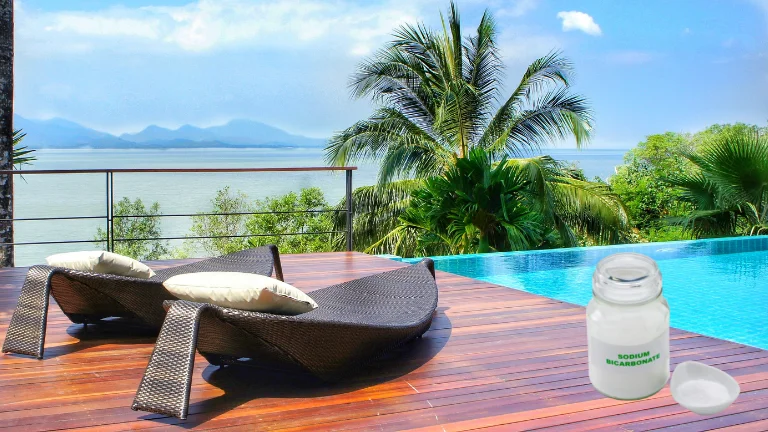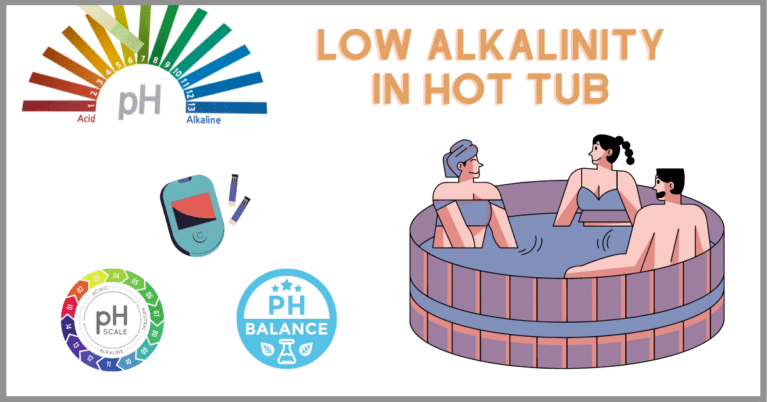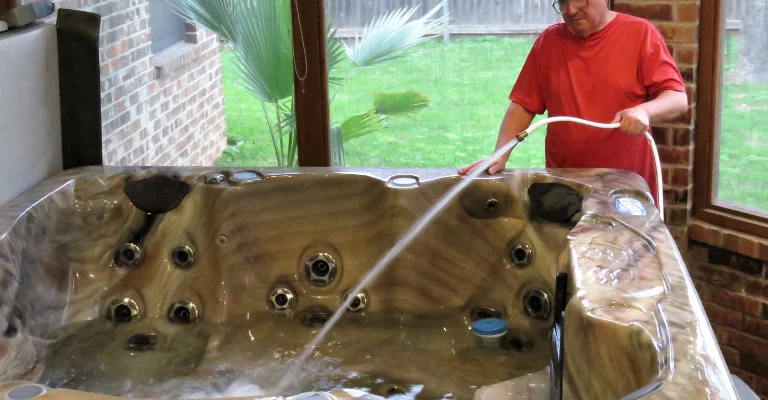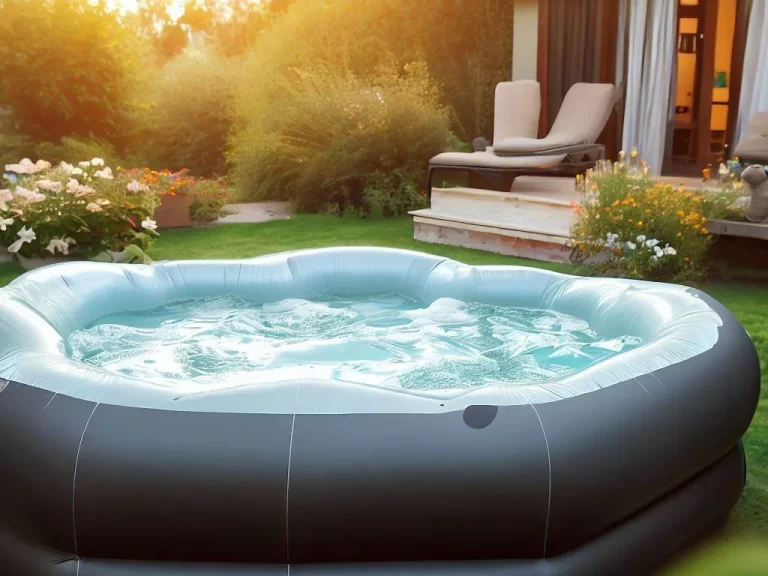Baking Soda in A Pool: Is It A Good Alternative To Chlorine
Enhance Pool Water Clarity and Balance with Baking Soda! Discover how baking soda in a pool maintenance routine can help maintain pH levels and clear your pool water. Dive into a cleaner, more enjoyable swimming experience today!
Baking soda, also known as sodium bicarbonate, is a naturally alkaline substance with a pH of 8. Baking soda can raise the pH and alkalinity levels when added to pool water. This can be beneficial for some reasons:
- Improved water clarity: Baking soda buffers the pH of pool water, which can prevent cloudiness and discoloration.
- Reduced eye and skin irritation: Baking soda can soften water and make it less irritating to the eyes and skin.
- Improved sanitation: A balanced pH level is essential for effective chlorine sanitation. Baking soda can help raise the pH level to an optimal range, enhancing the effectiveness of chlorine and other sanitizing chemicals.
- Prevention of algae growth: Algae thrive in acidic water. Baking soda can assist in raising the pH level and make the water less hospitable to algae growth.
What is the appropriate amount of baking soda to add to a pool?
Baking soda is a versatile and affordable tool for pool maintenance. It can help raise alkalinity levels, which can improve the stability of your pool’s pH and prevent corrosion. Table to help you determine the appropriate amount of baking soda to add to your pool:
| Pool Size (Gallons) | Baking Soda (Cups) |
|---|---|
| 1,000 | 0.5 |
| 2,000 | 1.0 |
| 3,000 | 1.5 |
| 4,000 | 2.0 |
| 5,000 | 2.5 |
Baking Soda Pool Calculator
Check out How to Measure a Pool in Gallons.
How to Add Baking Soda to Your Pool
Adding baking soda to your pool helps maintain the right pH balance, which is crucial for clean and safe water. Here’s a simple guide on how to do it:
Steps to Add Baking Soda
- Dissolve Baking Soda:
- Fill a bucket with water.
- Slowly add the baking soda to the water, stirring until it’s completely dissolved.
- Add to the Pool:
- Pour the dissolved baking soda solution into the pool.
- Move around the pool to spread it evenly.
- Circulate the Water:
- Run the pool pump and filter system for at least 6 hours.
- This helps mix the baking soda thoroughly throughout the water.
- Test the Water:
- After 6 hours, test the pH and alkalinity levels.
- Adjust if needed.
Safety Precautions
- Wear Gloves and Eye Protection: When handling baking soda.
- Avoid Dust: Add baking soda slowly to avoid dust clouds.
- Check pH Levels: Don’t add baking soda if the pH is above 7.8.
Why Use Baking Soda?
- Balancing pH Levels:
- Ideal pH range: 7.2 to 7.6.
- Baking soda helps keep the pH level balanced, preventing water from being too acidic or basic.
- Proper Dosage:
- For every 10,000 gallons of water, use about 1.5 pounds of baking soda to increase the pH by 0.1.
- This precise measurement helps avoid sudden changes in water chemistry.
- Avoiding Cloudy Water:
- Dissolve baking soda in water before adding it to the pool to prevent residue.
Application Tips
- Pour Slowly: Add the solution along the pool’s edge while the pump runs.
- Patience is Key: Let the solution circulate for several hours, or overnight, before testing.
Ongoing Maintenance
- Regular Checks: Frequently test the pool’s pH levels.
- Repeat as Needed: Add more baking soda when necessary to keep the water balanced.
- Monitor Alkalinity: Over time, baking soda also affects total alkalinity, so keep an eye on that too.

| Pros | Cons |
|---|---|
| Balances pH Levels: Helps maintain the ideal pH range of 7.2 to 7.6. | Alkalinity Impact: This can increase total alkalinity over time, requiring further adjustments. |
| Cost-Effective: Inexpensive and readily available. | Time-Consuming: Requires time to dissolve and distribute properly. |
| Safe for Swimmers: Non-toxic and gentle on skin and eyes. | Temporary Solution: Needs regular monitoring and reapplication. |
| Protects Equipment: Prevents corrosion and scaling of pool equipment. | Slow Acting: Takes several hours to integrate and show effects fully. |
| Easy to Use: Simple process of dissolving and adding to pool water. | Dust Clouds: Handling can create dust if not done carefully. |
| Slow Acting: It takes several hours to integrate and show effects fully. | Multipurpose: This can be used for other household cleaning tasks. |
Comparing Automatic and Manual Pool Chlorination
When it comes to keeping your pool sanitized, you have two main options: automatic and manual chlorination systems. Here’s a quick comparison to help you decide which one suits your needs best:
| Feature | Automatic Pool Chlorination | Manual Pool Chlorination |
|---|---|---|
| Chlorine Dosage | Consistently releases controlled chlorine levels. | The owner needs to manage pH separately. |
| Effort Required | Operates autonomously with minimal intervention. | Requires regular monitoring and adjustment by the owner. |
| pH Regulation | Some systems also monitor and adjust pH levels. | The cheaper upfront cost for equipment. |
| Controlled Application | Less direct control over chlorine levels. | Allows for precise adjustments based on pool conditions. |
| Flexibility | Limited flexibility in chlorine dosing. | Offers flexibility in adjusting chlorine as needed. |
| Initial Cost | Generally higher initial cost for equipment. | It is ideal for those seeking convenience and ease of use. |
| Best for | Ideal for those seeking convenience and ease of use. | Suited for individuals who prefer hands-on control. |
When choosing between automatic and manual pool chlorination systems, consider your lifestyle, level of involvement in pool maintenance, and budget.
Automatic systems offer convenience and consistent results, while manual systems provide more control and customization options.
Pool Temperature and Chlorination
The best way to determine whether your pool is too cold for swimming is to check the temperature of the water before you enter.
Typically, a residential pool designed for leisure should have a temperature ranging from 78°F to 82°F (26°C to 28°C). However, some temperatures may pose a risk to vulnerable individuals and can make your pool susceptible to contamination.
Generally, it is recommended that the pool temperature be kept between 77 and 84 degrees. A pool thermometer can measure this temperature.
Pool owners should consider both options for chlorinating their pools. Automatic systems are more efficient and can save money over time. Chlorine comes in various forms, such as:
- Tablets,
- Granules,
- Powders,
- Liquids,
- And gas.
Chlorine tablets or sticks are commonly used with automatic chlorinators. Chemical feeders, on the other hand, are designed to work with both chlorine and bromine.
There are 6 alternatives to chlorine, such as:
- Bromine
- Ozone generator (ozone pool system)
- Biguanide pool treatment (PHMB)
- Mineral sanitizers
- UV light purification systems
- And saltwater pools
Chlorine: Pros and cons
| Aspect | Chlorine – Pros | Chlorine – Cons |
|---|---|---|
| Applications | Used in water purification, pharmaceuticals, production of plastics and other synthetic materials, among others | Toxic and corrosive to metals |
| Production | Colourless gas with a faint bleach-like odor at room temperature | |
| Common use | Colorless gas with a faint bleach-like odour at room temperature | |
| Characteristics | Colorless gas with a faint bleach-like odor at room temperature | No known stable isotopes |
Is cloudy pool can be cleared by using baking soda?
Yes, baking soda can help clear a cloudy pool by raising the pH levels. Add about 5 pounds of baking soda per 10,000 gallons of water over 2-3 days. Check out for more about how to heat a swimming pool.
Closing Remarks:
Maintaining the right pH balance in your pool is essential for a safe and enjoyable swimming experience. By using baking soda, you can effectively manage and stabilize your pool’s water quality.
[wps_alert type=”note”]Remember to dissolve the baking soda thoroughly, add it carefully, and allow time for the water to circulate before testing. [/wps_alert]
Regular monitoring and adjustments will help keep your pool in perfect condition, ensuring crystal-clear waters and a pleasant swimming environment.
For more information about the Healing in Style guide or the Pools Guide,
Frequently Discussed Topics:
What are the benefits of using baking soda in a pool? It is a natural disinfectant that can kill bacteria and algae. It is also effective at removing stains and scales from pool surfaces.
How do I add baking soda to my pool? You can add baking soda to it by dissolving it in water and adding it to the water. You should start with a small amount and increase it as needed.
How often should I add baking soda to my pool? Depending on how often you use it, you must add baking soda regularly. You should check the water and adjust the amount of baking soda added.
How much should I add to my pool? Add it in small batches of about a cup at a time. Try to add up to one cup at a time. Add the baking soda directly to your pool water, do not mix it with other chemicals like chlorine or shock. Add your baking soda when the water is calm, about 70 degrees or less.
How do I know if it’s working? The first sign that your baking soda is working is a change in the pool water color. The water will turn milky white, and the smell should also change to a pleasant aroma.
How long do I need to add baking soda to my pool? Keep adding it as required until you no longer smell the chlorine odor in your pool or spa.
How do I know when to stop adding baking soda? You can feel the water with your hand. It will be very soft and silky. If you can still feel the minerals, add baking soda until they are gone.
How do I get the baking soda out of my pool? Add a large amount of chlorine to the collection. The baking soda and minerals will clump together and sink to the bottom. Vacuum it when you are done adding chlorine.
Is there a faster way to get the baking soda out of my pool? Add 1 cup of household ammonia to your pool and stir it around. It will dissolve into the water, and the chlorine will react with the ammonia.
Can other household cleaners remove the baking soda from my pool? Yes, you can use a high-pH (alkalinity) cleaner. You can also add vinegar or lemon juice.
Further Reading Related Article:
- Above Ground Pool Costco: Looking for an affordable and convenient way to enjoy a swimming pool in your backyard? Costco offers a wide range of above-ground, durable, easy-to-set-up, and budget-friendly pools.
- Solar Pool Vacuum Cleaner: Cleaning your pool doesn’t have to be a hassle or require excessive energy consumption. A solar pool vacuum cleaner is an eco-friendly and efficient solution to keep your collection clean and debris-free.
- DIY Solar Pool Heater: Want to extend your swimming season without increasing energy bills? Building a DIY solar pool heater can be a cost-effective and sustainable option.
- How to Heat a Pool Fast: When you want to enjoy a warm pool quickly, knowing how to heat it efficiently is essential. Discover effective methods and practical tips to heat your pool fast, ensuring optimal comfort and enjoyment for you and your family.
Have you tried using baking soda in your pool? If so, please share your experience and any helpful tips!














4 Comments